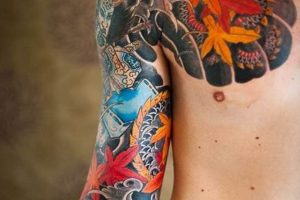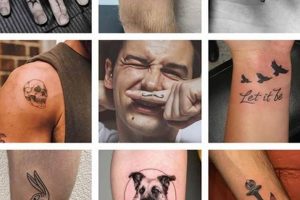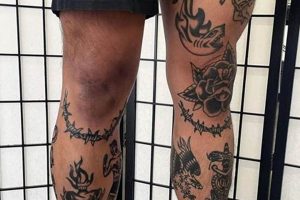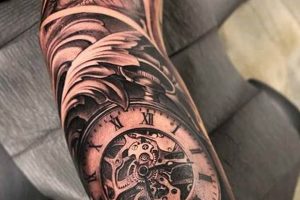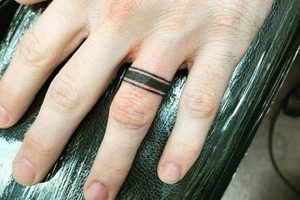Bicep tattoos for men offer a prominent canvas for artistic expression, ranging from small, symbolic designs to large, intricate artwork. A tribal armband, for example, can represent heritage and strength, while a portrait might memorialize a loved one. The placement on the bicep allows for easy visibility or concealment depending on attire.
The bicep’s well-defined musculature provides a dynamic surface, enhancing the visual impact of the tattoo. This location has been a popular choice for body art across cultures and throughout history, often signifying strength, status, or personal narratives. The relative lack of nerve endings in this area can also contribute to a less painful tattooing experience compared to other body parts.
Exploring design options, considering size and placement, and researching reputable artists are crucial steps in the process. Factors such as pain tolerance, lifestyle, and long-term aesthetic preferences should also be considered before committing to a bicep tattoo.
Tips for Bicep Tattoo Designs
Careful planning ensures a successful and satisfying bicep tattoo. Consider these essential factors before making a permanent commitment.
Tip 1: Research Artists Thoroughly: A reputable artist possesses a strong portfolio demonstrating skill in the desired style. Hygiene and safety practices are paramount.
Tip 2: Consider Design Placement and Size: The bicep’s shape and musculature influence how a design appears. Smaller designs suit the inner bicep, while larger pieces can wrap around the entire muscle.
Tip 3: Reflect on Long-Term Aesthetics: Tattoos are permanent. Choose designs with lasting significance, avoiding trends that might lose appeal over time.
Tip 4: Factor in Pain Tolerance: The bicep is considered a moderately painful area for tattooing. Discuss pain management options with the chosen artist.
Tip 5: Plan for Aftercare: Proper aftercare is essential for healing and preserving the vibrancy of the tattoo. Follow the artist’s instructions diligently.
Tip 6: Explore Diverse Styles: Research various tattoo styles, from realism and traditional to geometric and abstract, to find a style that resonates personally.
Tip 7: Consider Lifestyle and Profession: Certain professions may have restrictions on visible tattoos. Ensure the design aligns with career aspirations.
Thoughtful consideration of these factors contributes to a successful tattoo experience and a piece of art that provides lasting satisfaction.
By addressing these considerations, individuals can confidently embark on the journey of acquiring a meaningful and well-executed bicep tattoo.
1. Placement
Placement is a critical factor in bicep tattoo design, influencing both the aesthetic impact and the practicality of the piece. The bicep offers distinct zones, each presenting unique opportunities and challenges for tattoo placement. The inner bicep, often chosen for smaller, more personal designs, provides a less exposed area for those seeking discretion. This area can also accommodate designs that extend onto the inner arm, creating a cohesive flow. The front of the bicep, a prime location for showcasing prominent artwork, offers a larger canvas for intricate designs and benefits from the bicep’s natural curves to enhance the visual appeal. Wrapping designs around the entire bicep creates a three-dimensional effect, following the muscle’s contours. The outer bicep, highly visible, is ideal for bold statements and designs intended for maximum exposure. Consideration should be given to how the tattoo interacts with the arm’s natural movement and muscle flexion in this location.
A portrait, for instance, might be best suited to the front of the bicep to maximize visual impact, while a band of script could elegantly encircle the entire bicep. Practical considerations also influence placement decisions. Individuals in professions with dress codes might opt for the inner bicep to allow for easier concealment. Pain tolerance also plays a role, as the inner bicep tends to be more sensitive than the outer area. Understanding these nuances enables informed choices aligned with individual preferences and lifestyles.
Strategic placement maximizes a bicep tattoo’s artistic potential. Careful consideration of visibility, size, and the interplay between design and body contours ensures a visually appealing and personally meaningful result. Choosing the optimal location ensures the tattoo complements the wearer’s physique and effectively conveys the intended message, whether a bold statement or a subtle personal expression. The interaction between design and placement is crucial for creating a harmonious and impactful piece of body art.
2. Size and Scale
Size and scale are integral to the success of a bicep tattoo. The chosen dimensions significantly influence the design’s visual impact, its relationship to the bicep’s musculature, and the level of detail achievable. A small, intricate design might be lost on a large bicep, while an expansive, detailed piece could overwhelm a smaller arm. Careful consideration of scale ensures the tattoo complements the individual’s physique and effectively conveys the intended artistic expression. A small, symbolic design, such as a single rune or a minimalist animal silhouette, can be effectively placed on the inner bicep, creating a subtle yet impactful statement. Conversely, larger, more complex designs, like a detailed portrait or a full sleeve extension incorporating the bicep, require ample space to achieve the desired level of detail and visual impact.
The interplay between size and scale also affects the tattoo’s readability and longevity. Fine lines and intricate details in smaller tattoos may blur or fade over time, particularly on a dynamic muscle group like the bicep. Larger designs allow for bolder lines and more pronounced shading, contributing to the tattoo’s long-term visual integrity. For example, a large tribal design with thick, bold lines will age better and remain visually striking compared to a small, finely detailed script tattoo. This consideration is crucial for ensuring the tattoo remains aesthetically pleasing over time.
Balancing size and scale with the chosen design and the individual’s physique is essential for a successful bicep tattoo. Careful planning and consultation with a skilled tattoo artist will ensure the final piece is both visually striking and proportionate to the canvas. This harmonious relationship between size, scale, and the bicep’s contours contributes to a powerful and lasting piece of body art.
3. Style and Imagery
Style and imagery are fundamental to expressing personal narratives through bicep tattoos. The chosen style dictates the overall aesthetic, while the imagery conveys specific meanings and symbolism. A cohesive relationship between style and imagery is crucial for creating a powerful and resonant tattoo.
- Realism
Realistic tattoos strive for photographic accuracy, often depicting portraits, animals, or objects in meticulous detail. A realistic portrait of a loved one, for instance, can serve as a permanent memorial, while a detailed depiction of a favorite animal can reflect personal affinities. Realism requires a high level of artistic skill and careful consideration of shading, contrast, and color palettes.
- Traditional
Traditional tattooing, rooted in classic Americana and nautical imagery, features bold lines, vibrant colors, and iconic motifs such as anchors, roses, and eagles. These designs often carry symbolic weight, representing strength, resilience, or patriotism. Traditional tattoos maintain a timeless appeal and offer a distinct visual style.
- Tribal
Tribal tattoos draw inspiration from indigenous cultures worldwide, featuring bold, geometric patterns and often representing heritage, spirituality, or strength. Maori and Polynesian tribal designs, for example, are rich in symbolism and history. Tribal tattoos can be adapted to the bicep’s contours, creating visually striking armbands or flowing patterns.
- Japanese
Japanese tattooing, known as Irezumi, is characterized by intricate designs often featuring mythical creatures, natural elements, and vibrant colors. Dragons, koi fish, and cherry blossoms are common motifs, each carrying symbolic meaning within Japanese culture. Japanese-style tattoos often incorporate flowing lines and dynamic compositions that complement the bicep’s form.
The interplay between style and imagery allows for a diverse range of expressions within the realm of bicep tattoos. Selecting a style that resonates with individual preferences and choosing imagery that conveys personal meaning are essential for creating a tattoo that holds lasting significance. The chosen style influences not only the aesthetic but also the technical execution, requiring a skilled artist specializing in the desired approach. Ultimately, the synergy between style and imagery transforms a bicep tattoo into a powerful statement of personal identity and artistic expression.
4. Color and Shading
Color and shading are essential elements in bicep tattoo design, significantly impacting the visual depth, dimension, and overall aesthetic of the piece. Skilled application of color and shading can transform a two-dimensional design into a dynamic, visually arresting work of art. These techniques enhance the realism, impact, and longevity of a tattoo, playing a crucial role in how the design interacts with the contours of the bicep.
- Black and Gray Realism
Black and gray realism relies on subtle gradations of black ink diluted with water or a carrier solution to create a spectrum of tones, achieving a three-dimensional effect. This technique is often used for portraits, animals, or objects, mimicking the interplay of light and shadow. In bicep tattoos, black and gray realism can create powerful, dramatic imagery, leveraging the muscle’s curves to enhance the illusion of depth and form. A grayscale portrait of a historical figure, for instance, can convey a sense of gravitas and timelessness.
- Full Color Saturation
Full color saturation utilizes a vibrant palette of inks to achieve a bold, eye-catching effect. This approach is often employed in styles like traditional, Japanese, or neo-traditional tattooing. Bright colors can represent specific meanings or simply enhance the visual impact of the design. On the bicep, full color tattoos can create a striking focal point, especially for designs that incorporate elements like flowers, animals, or mythical creatures. A vibrant Japanese-style dragon, for example, can symbolize strength and power.
- Color Blending and Transitions
Color blending and transitions involve seamlessly merging different colors to create smooth gradients and subtle variations in tone. This technique adds depth and complexity to the design, enhancing the overall visual appeal. On the bicep’s curved surface, smooth color transitions can create a sense of movement and flow, particularly effective in designs featuring water, fire, or abstract patterns. A watercolor-style tattoo, for example, can leverage color blending to achieve a soft, ethereal effect.
- Shading Techniques for Depth and Texture
Various shading techniques, such as stippling, hatching, and whip shading, create texture and depth within a tattoo. Stippling uses small dots to build up shading gradually, while hatching employs parallel lines to create varying degrees of darkness. Whip shading combines curved lines and varying needle depths to achieve a smooth, blended effect. These techniques can be used in conjunction with color or black and gray to enhance the realism and visual impact of bicep tattoos. A textured tribal design, for instance, can leverage shading to create a sense of depth and dimension.
The strategic application of color and shading elevates bicep tattoos from simple designs to intricate works of art. By understanding the interplay of color, light, and shadow, skilled tattoo artists can create tattoos that possess depth, dimension, and lasting visual appeal. The chosen color palette and shading techniques contribute significantly to the overall aesthetic and the successful integration of the design with the bicep’s unique contours, ensuring a visually striking and personally meaningful piece.
5. Artist Selection
Artist selection is paramount when considering a bicep tattoo. A skilled artist translates concepts into visually compelling and technically sound realities. The bicep’s prominent location necessitates a design that complements the body’s natural contours. An artist specializing in specific styles, such as realism, traditional, or Japanese, possesses the technical expertise to execute those designs effectively on the bicep’s unique canvas. For example, an artist specializing in realistic portraits may not possess the same skillset as an artist specializing in traditional Japanese imagery. Choosing an artist with a portfolio demonstrating proficiency in the desired style is crucial. This ensures the final tattoo meets expectations in terms of quality, detail, and overall aesthetic.
Beyond technical proficiency, an artist’s understanding of anatomy and how tattoos interact with the body’s movement is critical, especially for a dynamic muscle group like the bicep. An experienced artist considers how the design will flex and move with the arm, ensuring the tattoo maintains its visual integrity over time. This knowledge also informs placement decisions, maximizing the design’s impact and minimizing distortion. Furthermore, a reputable artist adheres to strict hygiene and sterilization protocols, mitigating potential health risks associated with tattooing. Researching an artist’s reputation and verifying their adherence to safety standards are non-negotiable aspects of the selection process. For instance, an artist with numerous positive reviews regarding cleanliness and professionalism offers greater peace of mind than one with a history of hygiene-related complaints. Due diligence in artist selection minimizes potential complications and ensures a safe and positive tattooing experience.
Choosing the right artist is an investment in a high-quality, long-lasting piece of art. Thorough research, portfolio reviews, and consultations are essential steps in finding an artist whose style and expertise align with individual preferences and the specific demands of a bicep tattoo. A well-executed bicep tattoo enhances personal style and serves as a powerful form of self-expression. Selecting an artist who understands the client’s vision and possesses the technical skills to bring that vision to life is crucial for achieving a satisfying and enduring result. The synergy between a skilled artist and a well-chosen design ensures a bicep tattoo that remains a source of pride and personal significance for years to come.
Frequently Asked Questions
This section addresses common inquiries regarding bicep tattoos for men, providing factual information and clarifying potential concerns.
Question 1: How painful are bicep tattoos?
Pain levels vary based on individual tolerance, but the bicep is generally considered a moderately painful area due to its proximity to the inner arm. Discuss pain management options with the chosen artist.
Question 2: How long does a bicep tattoo take to heal?
Healing typically takes 2-4 weeks, depending on the size and complexity of the tattoo. Proper aftercare is crucial for optimal healing and color retention.
Question 3: What are the best design ideas for men’s bicep tattoos?
Optimal designs depend on individual preferences, but popular choices include tribal patterns, script, portraits, animals, and geometric designs. Consider the bicep’s shape and how the design will interact with muscle movement.
Question 4: How much does a bicep tattoo cost?
Costs vary based on factors like size, complexity, artist experience, and geographic location. Obtain quotes from multiple reputable artists before making a decision.
Question 5: Can bicep tattoos be covered up?
While clothing can conceal bicep tattoos, complete concealment may be challenging depending on the design’s size and color. Laser removal or cover-up tattoos are options for unwanted or faded tattoos.
Question 6: What are the potential risks of getting a bicep tattoo?
Risks include infection, allergic reactions to ink, and scarring. Choosing a reputable artist who adheres to strict hygiene protocols minimizes these risks.
Careful consideration of these factors contributes to a successful and satisfying tattoo experience. Consultation with a reputable artist addresses specific concerns and ensures informed decision-making.
Further research and consultation with experienced professionals are recommended for personalized guidance.
Conclusion
Bicep tattoos for men offer a powerful canvas for self-expression, ranging from small, symbolic designs to large, intricate artwork. Careful consideration of placement, size, style, and imagery ensures a cohesive and impactful result. Selecting a skilled artist specializing in the desired style and adhering to strict hygiene practices is paramount for a safe and successful tattooing experience. Factors such as pain tolerance, lifestyle, and long-term aesthetic preferences should inform design choices.
A well-executed bicep tattoo becomes an integral part of personal style, reflecting individuality and conveying meaningful narratives. Thorough research, thoughtful planning, and collaboration with a reputable artist contribute to a piece of body art that provides lasting satisfaction and serves as a powerful form of personal expression.



